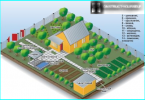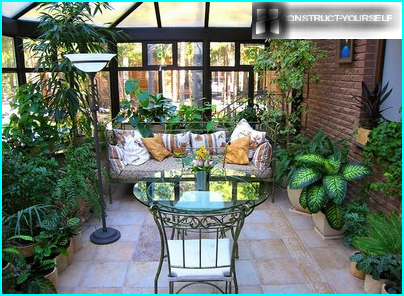
In any garden fruit or ornamental trees, there are some places, most of the time in the shade. Some of them are constantly shaded, so grass and flowers are deficient of sunlight. To the delight of gardeners, there is a large category of plants that are thriving in an unlit area, is a shade-loving perennials for the garden, which you can use to create a beautiful floral and herbal compositions.
The contents
The types of zones according to the degree of decoration
Depending on the location of the flower garden, its importance and the extent of the decorative groups of plants can be divided into three categories:
- classical composition;
- natural areas;
- accent flower beds.
On small clearings, along paths and fences, in places with open Vista, are classic designs for jewelry not sunlit areas. It’s a number of variety of herbaceous plants with ornamental foliage and shade-tolerant flowers for the garden, developing and gaining color for several years.
Natural areas are on the periphery, their main goal is to fill empty space and prevent the emergence of weeds. For the natural growth of an ideal planting periwinkle, Siberian brunnera, lungwort, Lily of the valley, of Dryopteris.
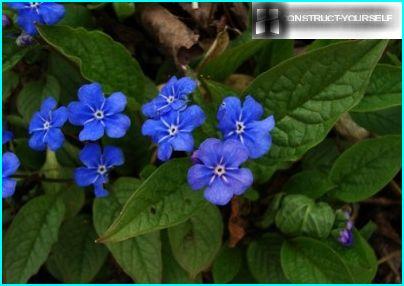
In slightly shady conditions thrive and bloom Brunner — a beautiful plant with blue or blue flowers similar to forget-me-nots
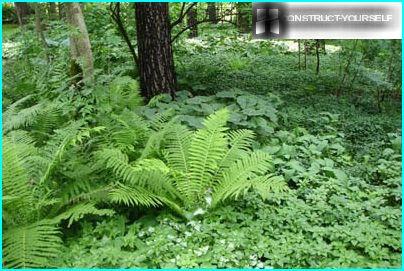
In addition to shade-tolerant flowers in the natural area use plants with ornamental leaves, ideal for the imitation of the wild, natural cover
Central garden areas and places for recreation are also often located in hidden from the sun areas, so especially for them there is a selection of accent plants, which are beautiful flowering and ornamental foliage: deveselu, Japanese anemones, the colorful, klopogona, astilbe.
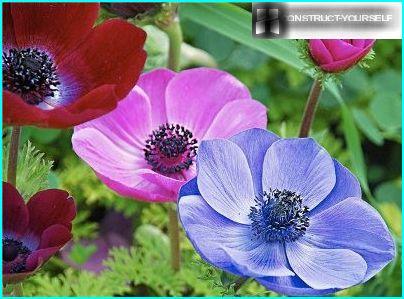
In shady places usually grow flowers with pale petals, but there are exceptions. Colorful anemones is an opportunity to create a bright floral arrangement on the dark areas
Shade-loving perennials for the seasons
Early spring primroses appear, gentle and humble that delight with their beauty for months. These include the European kandyk, different varieties of snowdrops Scilla. Later hatch dzheffersoniya doubtful, pechenocna and wood anemone (anemone).
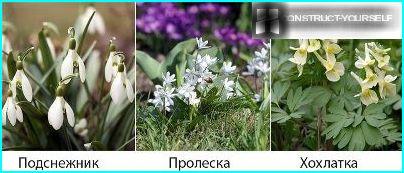
Primroses actively propagated by self-seeding, so during flowering it should detect new lesions and to monitor their spread throughout the territory of the country
In late spring appear the ruby aureoles cross ordinary and tiny flowers Soldanella. Against the background of low shrubs uvularia looks remarkably similar to the bell with yellow buds and silvery leaves. Yellow carpet creates and spring celandine blooming rounded small shrub. It is usually alternated with ferns. Bright composition can be composed of saxifrage, primroses and Phlox hybrid, creating a dense flower cover.
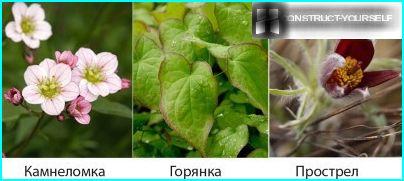
To create a spectacular flower garden suitable Saxifraga rotundifolia – plant plant with small white flowers and bright green ornamental foliage
The summer period is marked by the flowering martagon (martagon Lily). When initial landing of it is not luxurious buds, but in subsequent years it will look more beautiful. Among the lilies there are varieties that reach five feet in height, this factor must be considered during planting. Areas under low-lying trees are not suitable. The company lilies can be a bell point and Corydalis winding that also for flowering chose the warmest summer period.
First, the cold does not like shade-loving perennial flowers, so in the beginning of autumn reveal their buds but a few. The example of the late flowering is considered kirengeshoma delevigne with large decorative leaves and flowers-bells.
Three ideas for shaded flower beds garden
Use plants of different heights and colors to create original compositions. Of course, they will not be as vivid and lush as, for example, the rose bushes, but still able to charm his modest charm and gentle hues.
Option #1 — combined bed of 11 plants
This is an example of the composition of non-standard sample. For planting are the plants of different height and colors, and planted on a bed with dimensions of 2 m x 3 m. the Final form of the flowerbed receives only after 2-3 years when the plants reach their full development and gain the maximum color.

1.Anemone Asherah. 2. Astrantsiya. 3. Lily of the valley. 4. Corydalis. 5. The bleeding heart. 6. Digitalis. 7. Geranium versicolor. 8. Geranium is gorgeous. 9. Pechenocna. 10. Host. 11. Dryopteris
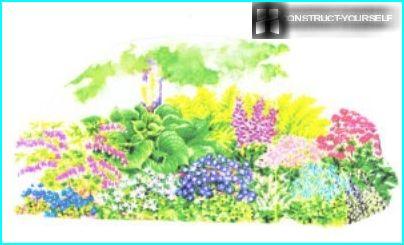
Plants are planted according to their size: at far higher flowers in the middle – curb and cover
Plants bloom at different times, one after the other, as a result, the bed looks presentable throughout the summer season. Suppose the timing of flowering anemones and Corydalis be the end of April, Lily of the valley – the beginning of may, direntry – June, astrantia – July and August. Many varieties of geranium are actively spreading the buds throughout the summer.
A special role belongs to such plants as the host and Dryopteris. They decorate the flower bed with no flowers, and the leaf plates. Hosta decorative foliage bluish tint is different and unique «waffle» texture and feathery leaves of Dryopteris – scaly texture.
Option #2 — perennials with bulbous
Well-known varieties of bulbs – daffodils, tulips, hyacinths – can be used as a bright accent in natural areas of shade-loving flowers for the garden. They will decorate the area on the stage when the perennials haven’t bloomed. To the faded bulbs in the future do not spoil the picture, they must carefully dig up and plant again in autumn for wintering. There is another option: grouse, tulips, daffodils, crocuses, can stand the winter without a transplant, and the next year encouraging more exuberant flowering.
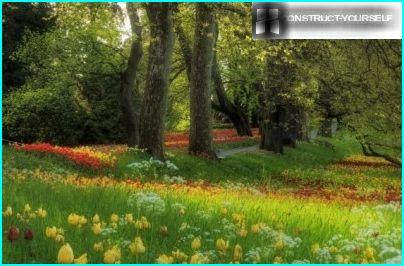
Along with perennials, tulips live in harmony in the gardens, copses and parks, despite the low sunlight and the density of sowing
Along with the tulips look great blue forget-me-nots. With a few varieties of tulips and forget-me-nots can create a multi-tiered composition on the background of a decorative shade-loving flowers perennials, they will look the most effectively. Don’t forget about marigolds: they are well tolerate shade and have protective anti-bacterial aura, useful for tulips.
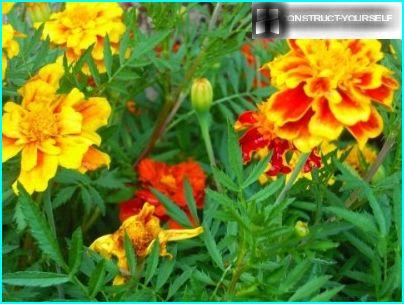
Marigolds feel great, and in open territories, and in the shade, so they are very fond of gardeners for the dilution of lawns, decorating shaded areas and borders
Option #3 — lawn grasses
Grass for lawns loves the sunshine and abundant watering, so shaded areas not suitable for any seed mix. Excluded Moorish and sports turf, but the presence of osanic in the mixture can be very useful. Varieties of osanic numerous, so for each region recommended their most suitable types.
For example, red fescue hard brings great shortage of sunlight, but does not like even a short drought and should be planted only in the presence of frequent watering. In addition, it is susceptible to fungal diseases and long-restores the root system when damaged. Longifolia fescue, by contrast, easily applies to drought and is not afraid of diseases, so it is good for planting in tight spaces that require minimal maintenance.
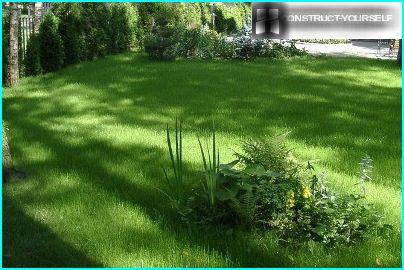
Red fescue is ideal for creating the basics of turf in shaded areas: it is unpretentious, grows quickly and is able to replace other types of lawn grasses
Related article: Features of ornamental grasses in landscape design
The creation of flower arrangements for a shady garden is a real art that requires knowledge and patience, but the result exceeds all expectations: instead of the wasteland appears a blossoming garden, and in the farthest corners of the arise amazing flower beds.
A selection of the best themed video
Video 1:
Video 2:
Video 3:






